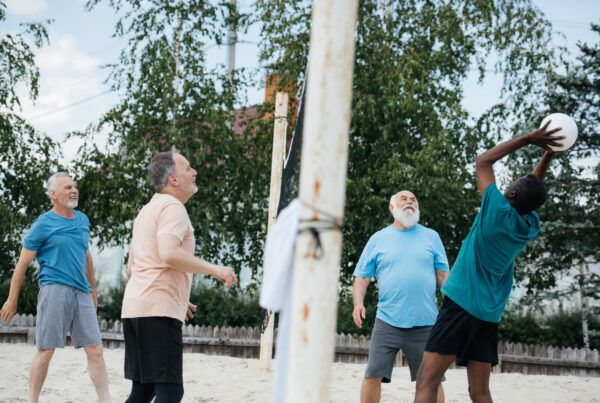”Question: Does exercise help traumatic brain injuries?
Reading time: 6 Minutes
MWi Hack:
- Learn about the impact that exercise can have on the recovery process after a TBI.
MWi Summary:
- Exercise helps stimulate neuroplasticity, which is the brain’s ability to repair itself.
- Strength exercises improve patients’ strength, coordination, and balance which also helps improve blood circulation to the brain.
- Trying new skills and hobbies improves mental health of patients as well.
- All kinds of exercise can help accelerate healing and overall improve quality of life for patients with TBI.
For example, 90% of patients can exercise after a mild traumatic brain injury (TBI), but patients are sometimes hesitant to experience a worsening of symptoms. Yet, what they may not know is that if patients do not exercise, it can lead to weight gain, depression, cardiovascular disease, or quitting positive habits they used to enjoy.
An exercise program is an essential part of neurological rehabilitation. Exercise will help patients gain strength and movement while improving cognitive functioning. Furthermore, it will also help patients experience an improvement in their mood while increasing self-esteem.
This article will share the reasons why exercise contributes to the rehabilitation of brain injury patients.
Neuroplasticity
Brain injury can significantly impair an individual’s brain function, causing different kinds of cognitive problems, such as:
- Loss of memory or difficulty in remembering information
- Difficulty in focus and concentration
- Reduced speed of thought and information processing
- Decreased learning ability
- Impairment with problem-solving skills and visual perception
Not all patients with brain injury suffer from the same cognitive problems. However, most patients experience some form of impaired brain function.
Fortunately, research suggests that there’s a simple yet effective way to bring back mental wellness, and that’s through exercise. According to the study, exercise facilitates neuroplasticity in patients with brain injury.
Neuroplasticity refers to the brain’s ability to repair itself. The brain does this by forming new synapses or connections between neurons. How does exercise prompt neuroplasticity in brain injury patients?
New connections form when stimulated by performing tasks and skills. Participation in a program such as strength or even mild aerobic exercises that are repetitive will promote neuron connections and recovery.
Furthermore, aerobic exercises can help enhance hippocampal size, thus increasing spatial memory and the brain’s executive function.
Accelerated Healing
TBI patients can accelerate their recovery by participating in simple rehabilitation exercises. For example, strength exercises help patients gain strength, coordination, and balance.
The following are some exercises that can improve strength and movement in TBI patients:
- Seated hip internal and external rotation
- Quad exercises
- Hip abduction
- Oblique crunches
- Calf raises
- Core toe taps
- Bicep Curls
- Shoulder flexion
Furthermore, exercise increases blood flow to the brain. When you exercise, your heart pumps blood to all areas of the body, including the brain. The increase in blood flow carries essential nutrients to the brain, promoting health and healing.
Development of New Skills and Hobbies
With participation in exercise programs, patients find they have an improvement in mood. Many want to continue exercising even after most of their symptoms have subsided.
Exercise affects neurotransmitters in the brain, which are the chemicals that transmit messages between neurons. Regular physical activity increases neurotransmitters, which helps brain injury patients process information faster and improves their mood! Because they feel well, patients want to continue exercising post-recovery.
Thus, patients often establish a life-long exercise habit in post-acute rehabilitation. For a pattern to form, start by doing at least some of your brain rehabilitation exercises every day. Eventually, it will just become part of your routine!
Improved Mental Health
According to a 2019 study, about 1 in 5 patients with mild traumatic brain injury can experience mental health symptoms and diseases after six months. Researchers identified that mild TBI increases one’s risk of developing disorders, like:
- Post-traumatic stress disorder or PTSD
- General anxiety disorder or anxiety attacks
- Major depressive disorder
- Chronic stress
One way to address this TBI side effect is through physical activity interventions and exercise programs. A growing number of studies suggest that exercise improves mood, enhances energy, and promotes social participation in individuals with brain injury.
Furthermore, participating in therapeutic physical activities has contributed to their fast rehabilitation, healing, and improved quality of life. Some of the exercises recommended by one study include aerobic activities, Tai Chi, and Qi Gong.
5 Rehabilitative Exercises After Traumatic Brain Injury
The American Physical Therapy Association recommends recovering TBI patients engage in healthy physical activities. Regularly exercising for 20 to 40 minutes at least three times a week can significantly benefit one’s cognition and cardiovascular health.
However, it’s essential to check with your doctor before participating in any exercise regime. It would also be more safe and efficient to seek guidance from your trusted traumatic brain injury rehabilitation center.
Rehab centers have licensed therapists that can evaluate your health before recommending a therapeutic fitness routine. They also know the types of exercise that you can do based on your age, fitness condition, and physical and mental limitations. Here are some of the best activities you and your therapist may work on:
Cardiovascular
Cardiovascular or aerobic exercises are workouts meant to increase the heart rate and respiration, thus strengthening the heart muscles and lung capacity. It also helps raise the oxygen levels in the body, keeping the blood circulation and the body’s systems healthy.
Aerobic exercises range from low impact to high intensity. For patients new to fitness activities, it’s important to start with mild to moderate intensity workouts, like walking and swimming. These two activities are easy to do but effectively build your endurance over time. Other exercises to try include:
- Jogging or using the treadmill
- Cycling or pedaling in a stationary bike
- Dancing
- Enrolling in aerobic classes
Strength Training
Strength or resistance training helps develop the body’s major muscle groups, thus promoting overall body strength. Additionally, this type of training encourages bone growth, manages weight and stress, and improves posture and balance. Some of the best routines to try include:
- Quad exercise – assume the starting position by lying flat on your back with your knees bent on the floor. Then straighten both knees by bringing your toes upwards (facing towards the ceiling).
- Squat exercise – start with a standing position where your legs should be shoulder-width apart. Next, send the hips back while bending the knees as if taking a seat. Keep your back straight, then hold the position. Then go back to the original standing position.
If this strength training seems too easy, you can add resistance bands or use free weights to enhance your body endurance workout. You can aim for at least 2 to 3 days of strength training per week to get all its benefits. Still, it will all depend on what your doctor recommends or your current condition.
Balance
Balance is a crucial ability to strengthen, especially for patients recovering from TBI. Balance training also helps you improve your body agility, coordination, and muscular strength. Additionally, improving balance reduces your risk of falling. Here are some workouts you can try to enhance your balance:
-
Weight shift
You can start by shifting your weight from one foot to another. Start by standing with your feet apart. Then let your right foot take most of your weight by slightly lifting your left foot off the ground. Hold the position while maintaining a good form and posture for 30 seconds. Then repeat it on the left foot.
-
Standing on one leg
For moderate balance training, you can try standing on one leg while lifting the other for at least 30 seconds. You can hold on to a chair for support then slowly remove it once you find your balance.
-
Heel to toe
Assume a standing position with the heel of your left foot almost touching the toes of your right. It’s like you’re walking where your feet are lined up in front of the other. Hold this position for 30 seconds with your eyes closed for added difficulty.
Other activities that can help improve your balance include yoga, pilates, and tai-chi. Just make sure that you enroll in a session specifically meant for patients recovering from traumatic brain injury.
Flexibility
Flexibility workouts enhance your range of motion and develop joint strength and muscle abilities. Furthermore, regular flexibility training can help prevent muscle stiffness, ataxia, and spasticity, which are all common problems of TBI patients.
Flexibility exercises are simply stretching routines that you can easily do throughout the day. For example, you can do a knee-to-chest stretch on your bed after waking up. Or you can perform a shoulder stretch (reaching one arm across the body and using the other to hold it) before your morning walk routine.
Just make sure to start your stretches slow and only up to the point of tightness, not pain.






